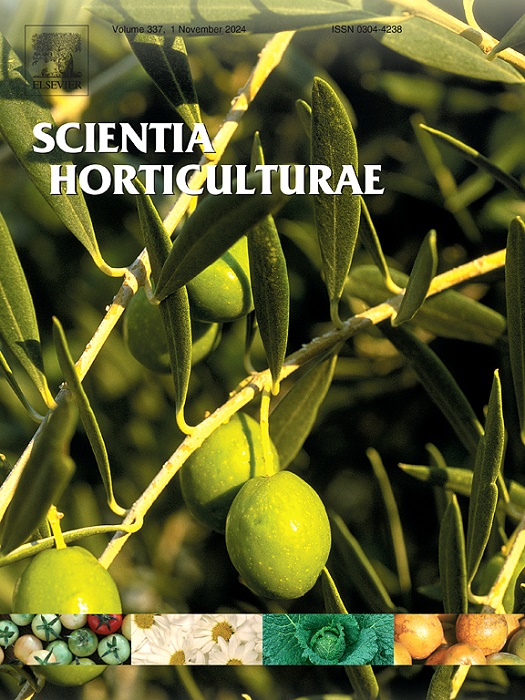综合代谢物分析揭示了椰子汁在果实发育过程中的生化演化
IF 3.9
2区 农林科学
Q1 HORTICULTURE
引用次数: 0
摘要
本文以文昌甜椰子(Cocos nucifera L。以海南高椰子(Cocos nucifera L.)为实验材料。“海南高”水作为对照。分析了椰子水中关键次级代谢物(包括酚酸、生物碱、萜类、木脂素和香豆素)在六个成熟阶段(I至VI,对应于2、4、6、8、10和12个月)的变化。使用液相色谱-串联质谱(LC-MS/MS)结合代谢组学方法进行代谢物分析和鉴别筛选。结果表明,两种椰子汁共鉴定出168种次生代谢产物,包括120种酚酸、26种生物碱、6种萜类、12种木质素和4种香豆素。在成熟过程中,HTC和WSC椰子水中次生代谢物的含量均有所下降,而WSC椰子水中次生代谢物的含量始终显著高于HTC和WSC椰子水。WSC和HTC在各成熟期差异表达的次生代谢物数量分别为78、47、54、68、80和62个。鉴定出主要代谢物,如胆碱、绿原酸和咖啡酸,以及30个特征次生代谢物。KEGG途径富集分析显示,次生代谢物主要富集于氨基苯甲酸酯降解(ko00627)、苯丙素生物合成(ko00940)和多种植物次生代谢物生物合成(ko00999)等8条代谢途径。本研究为椰子次生代谢产物的功能研究和产品开发提供了强有力的理论基础。本文章由计算机程序翻译,如有差异,请以英文原文为准。
Comprehensive metabolite profiling reveals biochemical evolution in coconut water during fruit development
In this study, Wenchang Sweet Coconut (Cocos nucifera L. 'Wenchang-Sweet') was selected as the experimental material, with Hainan Tall Coconut (Cocos nucifera L. 'Hainan-Tall') water served as the control. Changes in key secondary metabolites—includingphenolic acids, alkaloids, terpenoids, lignans, and coumarins—in coconut water were analyzed across six maturity stages (I to VI, corresponding to 2, 4, 6, 8, 10, and 12 months of age). Metabolite profiling and differential screening were performed using liquid chromatography-tandem mass spectrometry (LC-MS/MS) combined with a metabolomics approach. The results showed that 168 secondary metabolites were identified in the coconut water of both HTC and WSC, comprising 120 phenolic acids, 26 alkaloids, 6 terpenoids, 12 lignins and 4 coumarins. During the ripening process, the content of secondary metabolite in the coconut water declined in of both HTC and WSC coconuts, however, WSC consistently exhibited significantly higher levels. The number of differentially expressed secondary metabolites between WSC and HTC at each ripening stage was 78, 47, 54, 68, 80, and 62, respectively. Key metabolites such as Choline, Chlorogenic acid and Caffeic acid were identified, along with 30 characteristic secondary metabolites. KEGG pathway enrichment analysis revealed that secondary metabolites were primarily enriched in eight metabolic pathways including aminobenzoate degradation (ko00627), phenylpropanoid biosynthesis (ko00940) and biosynthesis of various plant secondary metabolites (ko00999). This study provides a strong theoretical foundation for functional research and product development related to coconut secondary metabolites.
求助全文
通过发布文献求助,成功后即可免费获取论文全文。
去求助
来源期刊

Scientia Horticulturae
农林科学-园艺
CiteScore
8.60
自引率
4.70%
发文量
796
审稿时长
47 days
期刊介绍:
Scientia Horticulturae is an international journal publishing research related to horticultural crops. Articles in the journal deal with open or protected production of vegetables, fruits, edible fungi and ornamentals under temperate, subtropical and tropical conditions. Papers in related areas (biochemistry, micropropagation, soil science, plant breeding, plant physiology, phytopathology, etc.) are considered, if they contain information of direct significance to horticulture. Papers on the technical aspects of horticulture (engineering, crop processing, storage, transport etc.) are accepted for publication only if they relate directly to the living product. In the case of plantation crops, those yielding a product that may be used fresh (e.g. tropical vegetables, citrus, bananas, and other fruits) will be considered, while those papers describing the processing of the product (e.g. rubber, tobacco, and quinine) will not. The scope of the journal includes all horticultural crops but does not include speciality crops such as, medicinal crops or forestry crops, such as bamboo. Basic molecular studies without any direct application in horticulture will not be considered for this journal.
 求助内容:
求助内容: 应助结果提醒方式:
应助结果提醒方式:


